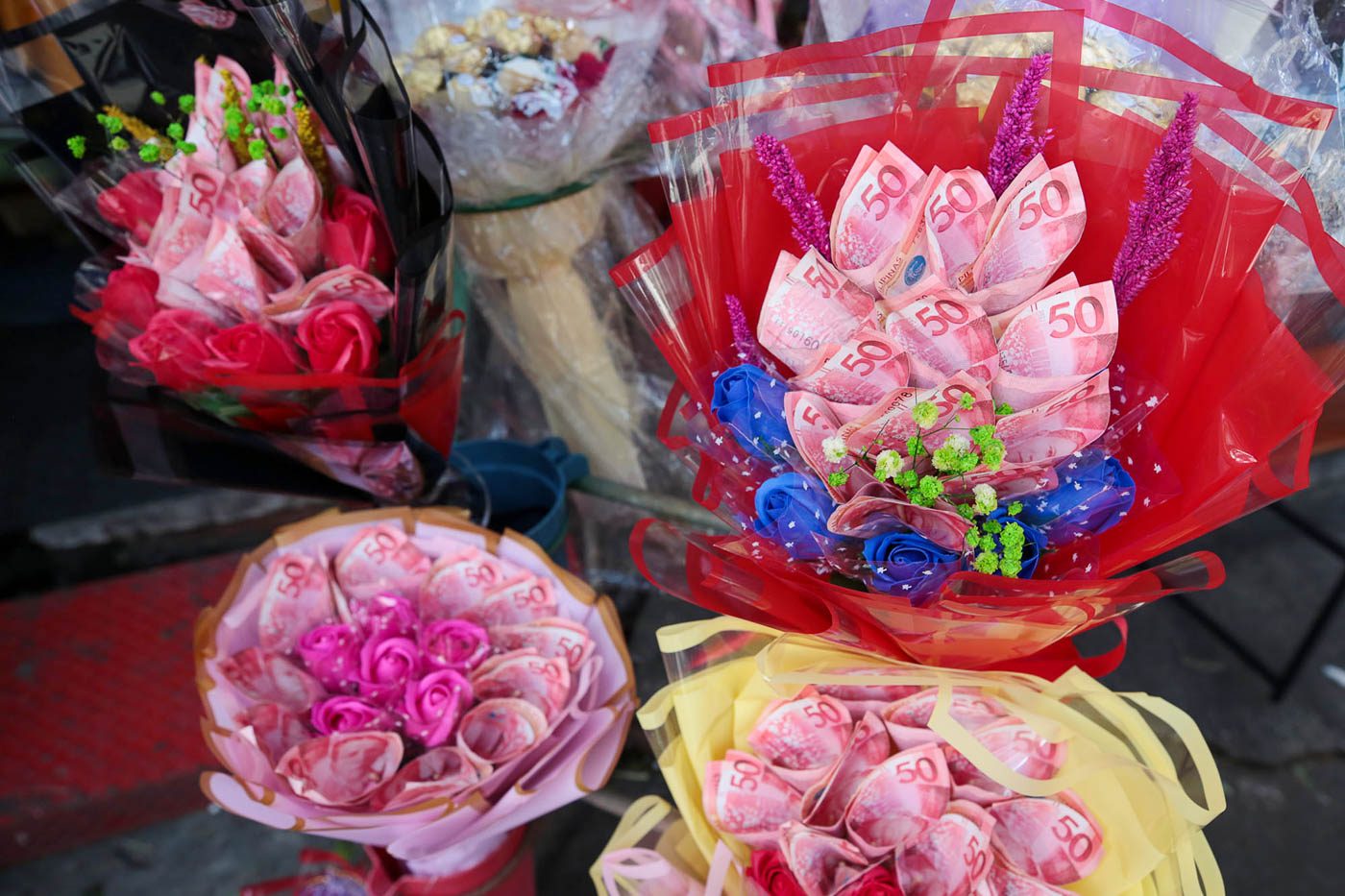SUMMARY
This is AI generated summarization, which may have errors. For context, always refer to the full article.

MANILA, Philippines – People who buy roses for Valentine’s Day are often shocked at how the prices go up the day before and on February 14. Roses that are sold at Dangwa Market in Manila, where many producers unload these flowers, cost around P70 to P80 each. But they’re sold in most other places for two, three, four, maybe even five times, especially in malls, during the very brief Valentine’s period.
I bought three on February 13, Tuesday, that cost me P450 or P150 each, double the wholesale price at Dangwa Market.
On Tuesday, a Department of Agriculture (DA) official proposed that instead of buying flowers this Valentine’s Day, people should gift their loved ones with rice instead.
“Ang dapat iregalo natin sa Valentine’s Day sa ating mahal sa buhay ay bigas, huwag na ‘yung flowers. Kasi hindi makain ‘yun, matinik pati. Kasi ang rosas ay matinik, pero matamis ang bigas. Bigas pa more,” Agriculture Undersecretary for Operations Roger Navarro was quoted as having said in a Palace briefing.
(We should give rice instead of flowers to our loved ones on Valentine’s Day. Because you can’t eat roses, and it’s thorny too. Roses are thorny but rice is sweet. Let’s have more rice.)
Navarro claimed that the rice supply in the country had improved and would lead to more stable prices in the coming months. Rice inflation was still high last December at 19.6%.
The steep prices of roses on Valentine’s Day is a good case to explain a number of economic principles.
First, the law of supply and demand. Roses are expensive on Valentine’s Day because demand is steep, while supply is limited. When demand falls the following day and thereafter, the prices of roses fall sharply.
Flower producers, distributors, and market sellers also hire more workers to meet the high demand in mid-February, and this increases the costs that they have to recover.
In the case of rice in the Philippines, President Ferdinand Marcos Jr. wants to bring the price of rice down to P20 per kilo, but it’s been a tall order because demand for rice remains high, while supply has not kept up with demand.
In the ’90s, for instance, national rice production was at 1.9% per year, while annual population growth was at 2.3%.
The Philippines has thus had to import rice to keep up with demand. If rice exporting countries, such as Vietnam, Thailand, and India, limit their exports, this affects supply leading to higher rice prices.
The Philippines is now the world’s largest rice importer.
Second, price inelastic or inelastic demand.
Roses on Valentine’s Day is a classic example of a product that is highly price inelastic. This simply means that people will still buy roses on February 13 and 14 even if the prices are steep.
For most buyers, they probably thought of buying something else, but had no choice because roses – not rice for many – symbolize love for one’s partner. Giving rice may not be a good idea too since eating too much white rice causes Type 2 diabetes.
Other products whose prices are inelastic are medicines, cigarettes, and oil.
Third, consumer behavior in economics.
The choices that consumers make affect scarcity of goods, which in turn affect prices.
Some of the Nobel Prize winners in economics have produced groundbreaking work on behaviorial economics.
If there comes a time when Filipinos will be giving rice instead of roses on Valentine’s Day, then that may lead to lower prices of roses during Valentine’s. Hopefully, the price of rice by then will be P20 per kilo, as the chief executive has promised.
However, changing consumer behavior takes a lot of work, especially in marketing. Since it’s been a long tradition to give flowers or chocolates on Valentine’s Day, don’t expect the prices of roses to fall on this day in the coming years.
In the meantime, there’s an interesting food for thought that has emerged from a recent survey by polling outfit Social Weather Stations (SWS).

In a December 8 to 11, 2023 national survey, 1,200 Filipino adult respondents were asked to give one answer to this open-ended question: Ano pong regalo ang gusto niyong matanggap mula sa inyong minamahal sa darating na Valentine’s Day? (What gift do you want to receive from your loved one this coming Valentine’s Day?)
The top 5 answers?
- Money: 16%
- Love and companionship: 11%
- Flower: 10%
- Apparel: 9%
- Any gift: 5%
So, why not give money in small red envelopes, like what the Chinese do during Lunar New Year? – Rappler.com
ALSO ON RAPPLER
- Here are the top 10 Victoria Court themed rooms – and how the motel chain conceptualizes them
- WATCH: Lovebirds Bob and Cynthia
- FVR and Ming’s love garden
- A getaway to the east: 5 under-the-radar spots in Rizal for Valentine’s Day
- Spread the love with these last-minute Valentine’s Day food gifts, date ideas
Add a comment
How does this make you feel?

![[OPINION] Time to seek justice, not hand out the Nobel Prize, for economic crimes](https://www.rappler.com/tachyon/2023/06/tl-economic-crimes.jpg?resize=257%2C257&crop=260px%2C0px%2C720px%2C720px)

There are no comments yet. Add your comment to start the conversation.